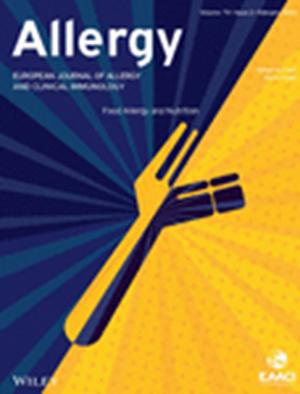Clinical Benefits of a Randomized Allergy App Intervention in Grass Pollen Sufferers: A Controlled Trial.
IF 12.6
1区 医学
Q1 ALLERGY
引用次数: 0
Abstract
BACKGROUND Symptom monitoring can improve adherence to daily medication. However, controlled clinical trials on multi-modular allergy apps and their various functions have been difficult to implement. The objective of this study was to assess the clinical benefit of an allergy app with varying numbers of functions in reducing symptoms and improving quality of (QoL) life in grass pollen allergic individuals. The secondary objective was to develop a symptom forecast based on patient-derived and environmental data. METHODS We performed a stratified, controlled intervention study (May-August 2023) with grass pollen allergic participants (N = 167) in Augsburg, Germany. Participants were divided into three groups, each receiving the same allergy app, but with increasing numbers of functions. PRIMARY ENDPOINT rhinitis-related QoL; Secondary endpoints: symptom scores, relevant behavior, self-reported usefulness of the app, symptom forecast. RESULTS Rhinitis-related QoL was increased after the intervention, with no statistical inter-group differences. However, participants with access to the full app version, including a pollen forecast, took more medication and reported lower symptoms and social activity impairment than participants with access to a reduced-function app. Using an XGBoost multiclass classification model, we achieved promising results for predicting nasal (accuracy: 0.79; F1-score: 0.78) and ocular (accuracy: 0.82; F1-score: 0.76) symptom levels and derived feature importance using SHAP as a guidance for future approaches. CONCLUSION Our allergy app with its high-performance pollen forecast, symptom diary, and general allergy-related information provides a clinical benefit for allergy sufferers. Reliable symptom forecasts may be created given high-quality and high-resolution data.随机过敏应用程序干预草花粉患者的临床益处:一项对照试验。
背景:症状监测可以提高对日常药物的依从性。然而,对多模块过敏应用程序及其各种功能的对照临床试验很难实施。本研究的目的是评估具有不同功能的过敏应用程序在减轻草花粉过敏个体症状和改善生活质量(QoL)方面的临床益处。次要目标是根据患者来源和环境数据开发一种症状预测方法。方法我们在德国奥格斯堡对草花粉过敏的参与者(N = 167)进行了一项分层对照干预研究(2023年5月- 8月)。参与者被分成三组,每组都使用同样的过敏应用程序,但功能越来越多。主要终点:与肾炎相关的生活质量;次要终点:症状评分、相关行为、应用程序的自我报告有用性、症状预测。结果干预后鼻炎相关生活质量提高,组间差异无统计学意义。然而,与使用功能减少的应用程序的参与者相比,使用完整应用程序版本(包括花粉预测)的参与者服用了更多的药物,并报告了更低的症状和社交活动障碍。使用XGBoost多类分类模型,我们在预测鼻腔(准确率:0.79;f1评分:0.78)和眼(准确率:0.82;F1-score: 0.76)症状水平和衍生特征重要性,使用SHAP作为未来方法的指导。结论我们的过敏应用程序具有高性能的花粉预测、症状日记和一般过敏相关信息,为过敏患者提供了临床益处。提供高质量和高分辨率的数据可以创建可靠的症状预测。
本文章由计算机程序翻译,如有差异,请以英文原文为准。
求助全文
约1分钟内获得全文
求助全文
来源期刊

Allergy
医学-过敏
CiteScore
26.10
自引率
9.70%
发文量
393
审稿时长
2 months
期刊介绍:
Allergy is an international and multidisciplinary journal that aims to advance, impact, and communicate all aspects of the discipline of Allergy/Immunology. It publishes original articles, reviews, position papers, guidelines, editorials, news and commentaries, letters to the editors, and correspondences. The journal accepts articles based on their scientific merit and quality.
Allergy seeks to maintain contact between basic and clinical Allergy/Immunology and encourages contributions from contributors and readers from all countries. In addition to its publication, Allergy also provides abstracting and indexing information. Some of the databases that include Allergy abstracts are Abstracts on Hygiene & Communicable Disease, Academic Search Alumni Edition, AgBiotech News & Information, AGRICOLA Database, Biological Abstracts, PubMed Dietary Supplement Subset, and Global Health, among others.
 求助内容:
求助内容: 应助结果提醒方式:
应助结果提醒方式:


